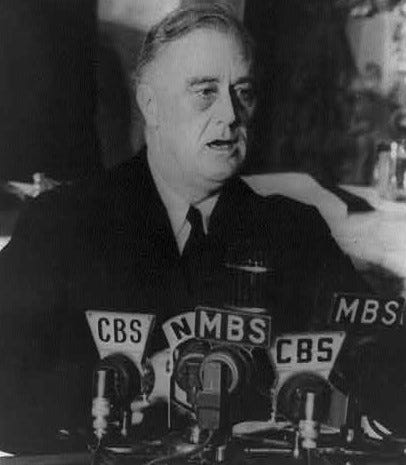FDR's 'Four Freedoms' speech
On the afternoon of January 6, 1941, President Franklin D. Roosevelt went before a joint session of Congress and delivered what would come to be known as the “Four Freedoms” speech. It stands in history as one of his best-known orations, perhaps second only to the speech he delivered 11 months and two days later, after the Japanese attack on Pearl Harbor.
The ideals that gave that particular State of the Union speech its name — freedom of speech, freedom of worship, freedom from want, freedom from fear — inspired a series of Norman Rockwell paintings that ran in four consecutive issues of the Saturday Evening Post in 1943. Decades later, Roosevelt’s words were chiseled into the granite walls at the FDR Memorial in Washington.
The four freedoms’ place in the American rhetorical canon is secure, but that particular section of his speech was not necessarily the focus of press coverage at the time.
Though the New York Times’ Page 1 story by Frank L. Kluckhohn alludes to the four freedoms in its opening sentence, it doesn’t get into the details until more than halfway through the story, after the jump on Page 3. And Robert C. Albright’s Washington Post account mentions the freedoms only at the very end, devoting the last four paragraphs of the story to Roosevelt’s “picture of the world of tomorrow as he hopes it will be.”
High-minded and inspiring as Roosevelt’s concept was, news reports zeroed in on the more immediately applicable segments of the speech in a world that had been at war for nearly a year and a half. Namely, his strongest public statements to date about where the still officially neutral United States stood in the ongoing conflict.
With isolationist sentiments still running strong across the country, he made clear the stakes: “at no previous time has American security been as seriously threatened from without as it is today.”
“The democratic way of life is at this moment being directly assailed in every part of the world — assailed either by arms or by the secret spreading of poisonous propaganda by those who seek to destroy unity and promote discord in the nations still at peace,” he continued. “During sixteen months this assault has blotted out the whole pattern of life in an appalling number of independent nations, great and small. The assailants are still on the march, threatening other nations great and small.”
The overall message was loud and clear, and received with jubilation across the English-speaking world.
The lead editorial in the Jan. 8 Sydney Morning Herald was entitled “America’s Hat in the Ring” and began: “President Roosevelt’s momentous message to Congress confirms that for the United States the die is cast.”
The editorial board later continued:
This message to Congress will go down as one of the most significant in American history. On primarily moral grounds, and departing from all tradition, a President of the United States has not hesitated to urge a militant national policy on the grounds of supporting a European struggle for freedom, and he urges such a policy in the knowledge that it may involved the United States, too, in a life-or-death conflict.
Many of those commenting on the speech drew a line back to Roosevelt’s Dec. 29, 1940 address in which he had urged the nation to “be the great arsenal of democracy,” assisting Britain in its fight against Nazi Germany.
In Manchester, The Guardian noted “these two speeches mark, indeed, a turning point in American foreign policy. … We on this side could not hope for anything more heartening or more frank. And it is gratifying indeed to see that the president is speaking for a united people which responds to his leadership.”
That last part was still a bit of a stretch, as significant opposition to American intervention remained in place for months to come. But the momentum was there, and would be borne out in practical terms with the passage of Lend-Lease two months later.
Even the Chicago Tribune, no fan of Roosevelt’s, agreed with the overarching message delivered by the president. Its editorial instead took issue with the way in which he delivered it, criticizing what it called his alarmist tone and his lack of specific requests to Congress to address the concerns he had outlined:
There was no occasion for passionate denunciations, no occasion for angry words, and exhortations. What was needed and still is needed is a reasoned, temperate account of the situation, and a program for increasing the productivity of our armament industries. Mr. Roosevelt failed at both points. It therefore remains for Congress to do what he has shown himself capable of doing: keeping a clear head.
That take left the Tribune as a clear outlier in terms of editorial board response to the speech. The New York Times cast the address in broader terms, correctly predicting how the message would be received by the British, French, Greeks, and others engaged in the fighting before turning the focus back to the audience at home.
There cannot be the slightest doubt that the course to which Mr. Roosevelt pledged this country yesterday has the endorsement of the vast majority of our people, and that they will approve whatever measures are needed to put it into practice. In an hour of great crisis the President has spoken to the nation with candor and with foresight. His message is a confession of deep faith, a summons to duty and a call to action.





